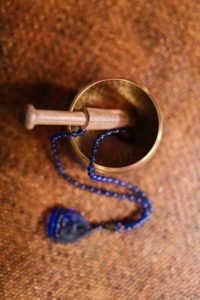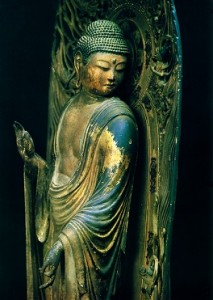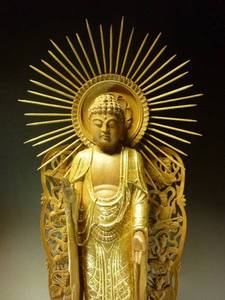Entrust, Receive, Awaken
Shin Buddhist wisdom invites us to awaken not by striving for perfection, but by opening our hearts to the boundless compassion already embracing us. Rooted in the teachings of its founder, Shinran Shonin, this path blends deep trust, gratitude, and humility with everyday life, offering a spirituality that meets you where you are. In moments of reflection, joy, and even struggle, the light of Amida Buddha shines, guiding us toward freedom and peace.
Unlike traditions that emphasize self-powered effort or long hours of meditation, Shin Buddhism points to awakening through Other Power (grace) through the inconceivable dynamic activity of the Great Compassion, known as Amida Buddha. Rather than seeking to overcome our limitations by pure will alone, we awaken through trust, surrender, and gratitude, realizing that enlightenment is not achieved but received in the here and now. This spiritual approach harmonizes beautifully with modern life, offering a refuge of humility and joy amid the challenges of our daily world.
In this light, spirituality may be understood as the free search for and personal engagement with the sacred, a living experience that offers continuous awakenings of personal and collective meaning through interconnectedness and insight into the sublime. Spirituality is not dependent on religion although it can be integral within religious institutions: its structures, teachings, and rituals. It is not dependent on any dogmatism or even connected to a deity; rather, it is the insightful expression of one’s personal journey whose source comes from an inner universal voice deep within. Even the most ardent atheist, who receives insight and meaning from the universe or nature, can be considered very spiritual, such as the esteemed scientists Richard Dawkin and the Carl Sagan.
 The English word “spirituality” has its origins from the Latin word “spiritus” which means life, energy, and breath, and the Latin verb “spirare” which means to breathe. Thus, spirituality can be likened to the life-giving act of breathing. The function of breathing is a natural gift that works independently of our self-manipulations as an unconscious working of the body. If we are mindful of this natural activity, we will notice its rhythms and its nourishing affect. When we inhale, we take in the entire universe into our bodies; the oxygen is connected with the plants that produced it. The plants are associated with the soil, the worms, the rain, the clouds, the sun and cosmic radiation; and these things are interconnected with everything else. When we exhale, we share our deepest bodily essence with the universe. Our breath contains liquid, gases, and chemicals that were moments before intimately within our flesh and now are freely given to the world for others to inhale. Likewise, spirituality is both a natural embodiment and realization that we are integrally part of the ineffable cosmic flow and dance of life. In other words, it is a movement of the heart that unites us with “the true and real life” or as we say, Boundless Life and Light that is within and beyond us.
The English word “spirituality” has its origins from the Latin word “spiritus” which means life, energy, and breath, and the Latin verb “spirare” which means to breathe. Thus, spirituality can be likened to the life-giving act of breathing. The function of breathing is a natural gift that works independently of our self-manipulations as an unconscious working of the body. If we are mindful of this natural activity, we will notice its rhythms and its nourishing affect. When we inhale, we take in the entire universe into our bodies; the oxygen is connected with the plants that produced it. The plants are associated with the soil, the worms, the rain, the clouds, the sun and cosmic radiation; and these things are interconnected with everything else. When we exhale, we share our deepest bodily essence with the universe. Our breath contains liquid, gases, and chemicals that were moments before intimately within our flesh and now are freely given to the world for others to inhale. Likewise, spirituality is both a natural embodiment and realization that we are integrally part of the ineffable cosmic flow and dance of life. In other words, it is a movement of the heart that unites us with “the true and real life” or as we say, Boundless Life and Light that is within and beyond us.
From the Shin context, spirituality is informed by an appreciative awareness of the inconceivable interconnection (pratitya-samutpada) between animate and inanimate life, such as people, civilization, animals, plants and rocks, and a conferred understanding, that is translated in everyday life as gratitude, for the interplay between the blessings and challenges that allow us to live and learn along the journey of life. Likewise, as the breath gives life to the body, our spirituality breathes renewed life into the mind and heart; it exposes and softens the karmic negativity with the light of wisdom, like ice is melted into water by the sunlight. Shin spirituality engages us to be open to and curious with the world, and to be vulnerable and open to the unexpected, and thus to be naturally receptive to inner transformation that comes from the very source of life itself.
The below article is an expression of Shin spirituality. It was written by Dr. (Rev.) Taitetsu Unno who many considered to be the Western world’s foremost Shin teacher, and the main lineage teacher of our founder, Rev. G.R. Lewis, M.A. This is an excerpt from a chapter from his classic book, River of Fire, River of Water (Random House, 1998); see out Recommended Books web page for more information.
“In 1975 I taught at the University of Hawaii as a visiting professor of philosophy and religion, and simultaneously I was appointed as the Scholar-in-Residence at the Buddhist
Study Center (BSCO located near the campus.) BSC is part of the Shin Buddhist organization known as the Honpa Honwanji Mission of Hawaii. At this center I gave weekly lectures on Shin Buddhism to a general audience reflecting the multiethnic makeup of the community. Among the regular participants was a Caucasian woman who came to participate from Wahiawa, a small town in Oahu, about a forty-five-minute drive from the Center.
One day she asked me to visit her mother in the Wahiawa General Hospital. The mother was eighty-six years old, totally deaf, and absolutely refusing to eat. This caused great distress and anguish for the family, and they wondered whether I could talk their mother into eating again. On the day I had agreed to visit her, I had a heavy schedule, so I had no time to prepare what I might say. I would be meeting a complete stranger who was deaf and who had never been exposed to Buddhism.
I was picked up and taken to the hospital where I was introduced to the mother. Although gaunt, pale, and looking weak, she struck me as the epitome of stubborn old age. When I held her hands, however, a faint smile crossed her face; her whispering was barely audible, but I understood that she had been waiting for me.
I took the writing pad next to her bed and with a felt pen wrote in large, bold letters, so the deaf woman could read them easily.
Your body is a container of life. It contains true and real life. Your body and your true and real life are two different things, related but different.
I tore off the sheet of paper and handed it to here. Then, I immediately began writing on the second sheet of paper:
Your body is old and tired and doesn’t want to go on living anymore, but true and real life within you is not. In fact, it wants to live on forever.
Tearing off this sheet and handing it over to her, I continued writing on eleven successive pages:
You have taken care of your body up to now, but now you must take care of true and real life that flows within you. Something deep within you wants you to awaken to the precious life that moves within you.
As you awaken to true and real life within you, you will feel good and warm and alive. Then everyone, including those who love you, will also awaken to that same true and real life.
Although I don’t know you at all, in one sense I have always known you—through true and real life that flows in you and me and everyone around us. Because of this shared life, I love you deeply as I love myself deeply.
When we appreciate true and real life that flows in the deepest parts of ourselves, then we also take good care of its container, this body, for without it we could never have come to realize true and real life.
To die or not to die—we really don’t have a choice. If we could choose, it would make things so simple. All we can do is to take good care of our body and our life, until the fullness of time and being brings to a close our existence on this earth.
As the woman read each successive page slowly as it was passed on to her, she became more and more alert, and her eyes focused on each word.
In my own life I often forget about true and real life deep within me. But whenever I do and get lonely, unhappy, frustrated, or angry, something deep within me calls me to awaken to true and real life.
 The call is a call for me to return to my real home, the home of homes, where all existence really comes alive. I hear the call through the words, namu-amida-butsu. This is known as the Name-that-calls.
The call is a call for me to return to my real home, the home of homes, where all existence really comes alive. I hear the call through the words, namu-amida-butsu. This is known as the Name-that-calls.
Namu is me—lost, confused, and wanting to find my real home. Amida is Immeasurable Life and Light—true and real life which is my home of homes. Butsu is Buddha—the awakening to this true and real life. The three are not separate but one, so we say namu-amida-butsu.
In response to the Name-that-calls, I say namu-amida-butsu. This is my acceptance and affirmation of true and real life. No need to understand, no need to explain anything, no need to convince anyone. Just namu-amida-butsu.
Although I myself am incapable of truly loving another person, many people love me—many times in ways unknown to me. Although I fail to appreciate  others’ concern for me, they truly sustain my life. But when I live namu-amida-butsu, I am made to appreciate others and want to thank them—all this by virtue of true and real life.
others’ concern for me, they truly sustain my life. But when I live namu-amida-butsu, I am made to appreciate others and want to thank them—all this by virtue of true and real life.
I am then filled with warmth, love, and compassion. May you awaken to true and real life that flows in you, me, your loved ones, and all beings. Thank you for listening—not to me but to the call of true and real life coming from deep, deep within you and me.
Although I had a particularly heavy schedule that day—sitting meditation in early morning, meeting with students during the day, TV taping in the late afternoon, and preparing for the weekly Tannisho lecture that evening—the details have all but faded from my memory into the nebulous past. I learned later that she did begin eating again, but what remains with me is the gaunt yet hopeful face of the old woman, anticipating each sheet of paper.”
Copyright 2014. Buddhist Faith Fellowship, All Rights Reserved.
Shin Buddhist Wisdom & Spirituality, Written by Rev. G.R. Lewis, M.A.
The BFF of CT grants permission to copy this document for personal use and for NASBA chapters only.
